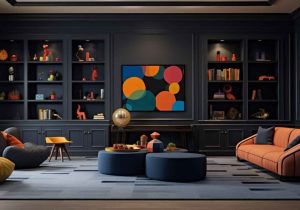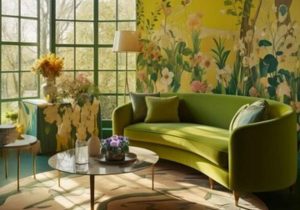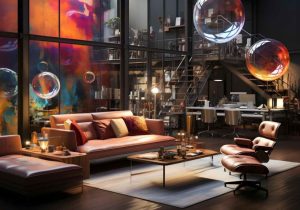In recent years, neurodiversity has gained increasing recognition in India, highlighting the unique needs and experiences of individuals with neurological differences. Conditions such as autism, ADHD, and many others fall under the neurodiversity umbrella, each presenting unique challenges and strengths.
The way spaces are designed can significantly impact the daily lives of these individuals, making interior design a key element in creating environments that support their sensory needs and preferences.
We will guide readers through the basics of sensory-smart interior designs. It explores how to bridge the gap between general visual artistry and the real needs of neurodiverse individuals. The focus here is on those who experience the world differently, emphasizing designs that cater to an extended sense of sight, hearing, smell, touch, and spatial awareness.

Neurodiversity refers to the variety of neurological differences that are a natural and valuable part of human diversity. In India, there’s a growing recognition of neurodivergents excelling in various fields.
Notable examples include individuals like Bakshi, who is celebrated as India’s first autistic model. These examples showcase the potential for neurodiverse individuals to thrive with the right support and opportunities.
Creating environments that accommodate these diverse needs is crucial. Neurodiverse individuals may have hypersensitivities to sensory inputs like light, sound, or textures, or they might require specific arrangements to feel comfortable and focused.
Understanding these needs is essential for designing spaces that are not only physically welcoming but also psychologically supportive, enhancing their ability to function and succeed in spaces tailored to their sensory profiles and promoting inclusivity and understanding in every corner of society and the built environment.
In India, interior design elements such as color, light, texture, and space organization significantly influence both culture and sensory perceptions, making them crucial for neurodiverse individuals. Colors in Indian culture often express emotions or elements of nature. For neurodiverse individuals who are sensitive to visual stimuli, softer shades like blues and greens are preferred for their calming effect, contrasting with vibrant reds and oranges which might overstimulate.
Light plays another vital role. Natural light is preferred for its calming effects and ability to enhance mood and cognitive function. However, for some neurodiverse individuals, direct sunlight can be overwhelming, necessitating the use of dimmers or blinds to adjust indoor lighting. Likewise, textures in the environment should be soft and gentle rather than harsh and overly textured, to avoid sensory discomfort or overload.
Space organization in Indian homes typically prioritizes functionality and energy flow, but for neurodiverse individuals, creating clear zones and quiet spaces is essential. These spaces allow for retreat and rejuvenation away from sensory over stimulation, ensuring the environment supports their unique needs while remaining culturally resonant.

Each room requires thoughtful consideration of its function and the specific needs of its occupants. Here are some tailored strategies:
Bedrooms: Should be calm sanctuaries. Use muted colors and soft fabrics to minimize sensory stimuli. Weighted blankets can provide comfort, and soundproofing may be necessary to block disruptive noises.
Living Areas: Should offer both retreat spaces and engagement zones. Various seating options, like bean bags or built-in nooks, can cater to different sensory needs. It’s important to maintain a clutter-free environment with adjustable lighting to ensure tranquility.
Workspaces: For individuals with ADHD or autism, a distraction-free workspace is crucial. Desks should face away from high-traffic areas, looking towards serene, green spaces. Ergonomic furniture customized to the user’s needs is also essential.
Educational Environments: Classrooms and study areas should have flexible seating and quiet zones for personalized learning or one-on-one interactions. The integration of technology that supports individualised learning experiences is also beneficial.
These room-specific strategies aim to create supportive, inclusive, and adaptable environments, ensuring that spaces not only function well but also nurture those with neurodiversity, allowing them to thrive in their personal and educational pursuits.
In designing spaces for neurodiverse individuals, the selection of innovative materials and adaptive technologies is crucial in enhancing both comfort and functionality. Chromotherapy lighting, which uses various colors to influence mood and mental state, stands out as particularly beneficial. It’s especially useful for individuals with anxiety or sensory processing issues, allowing the customization of environments to suit their emotional and cognitive needs.
The use of non-toxic materials is also essential, given that neurodiverse individuals may be more susceptible to toxins and chemicals typically found in conventional building materials and finishes. Options like zero-VOC paints, natural fibers in furnishings, and the avoidance of synthetic fragrances help create a safer indoor environment, minimizing potential irritants.
Moreover, incorporating soundproof materials in walls and floors can significantly enhance living and learning spaces for those with auditory sensitivities. Technologies such as noise-cancelling headphones and sound modulation devices are also vital in managing auditory input in overly stimulating environments.

When creating or renovating spaces with neurodiversity in mind, consider these actionable tips:
Prioritize simplicity in design to prevent sensory overload.
Implement flexible lighting solutions, such as dimmable LED fixtures, to adjust light intensity based on individual needs.
Opt for furniture with rounded corners and soft, natural fabrics to boost physical comfort and safety.
Establish designated quiet zones in homes or educational settings, equipped with sound-absorbing panels and soft furnishings, to offer a retreat for sensory breaks.
Regularly consult with neurodiverse individuals or specialized designers to ensure that the environment aligns with their specific sensory preferences and requirements.
In conclusion, Bonito Designs stands at the forefront of designing for neurodiversity, showcasing intuitive architecture and sensory-smart interiors that cater to a broad spectrum of needs.
We are dedicated to providing end-to-end solutions, ensuring that each space we design and build meets the highest standards of excellence and functionality. Our clients are our most valuable assets, and we are committed to delivering exemplary services tailored to meet each unique requirement.
At Bonito Designs, we pride ourselves on being a leader in the industry, especially with our status as the first-ever ISO-certified brand in Indian interior design. This certification reflects our commitment to quality and safety in every project. Our design process is thorough, including over 400 tests and 7 quality checks, guaranteeing that each space is not only aesthetically pleasing but also optimally safe and comfortable.
Our team of over 300 skilled designers excels at creating environments that enhance the well-being of all occupants, carefully considering elements from color and light to texture and space organization. With our in-house manufacturing capabilities, we ensure a high level of customization, particularly vital in designs friendly to neurodiverse individuals.
Understanding the importance of affordability, we offer easy EMI options to ease financial strain and ensure that your dream home becomes a reality. Additionally, our promise of a 90-day delivery allows you to enjoy your newly designed space sooner rather than later.
Choose Bonito Designs for your forever home. Let us design your dream home into a beautiful, supportive, and enriching environment for everyone in your family, regardless of their sensory needs.